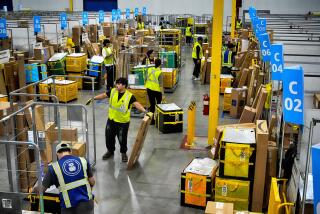U.S. Worker Productivity Up 2.3%; Rise in Labor Costs Slows
WASHINGTON — Productivity of American workers jumped in the third quarter while the increase in labor costs slowed, two healthy signs for the economy, government figures showed Tuesday.
Productivity rose at a seasonally adjusted annual rate of 2.3% in the quarter, the Labor Department said, after a meager 0.3% rise in the second quarter. The report measures the hourly output of workers outside the farm sector.
“We’ve had a pretty good run of productivity increases if you look back over the past year,” said Cynthia Latta, economist at DRI/McGraw-Hill in Lexington, Mass.
Rising productivity is key to the economy because when workers produce more per hour, businesses can keep their prices low without cutting into profits.
Latta attributed recent productivity gains to two factors.
First, with workers scarce--the 4.6% unemployment rate is near the lowest in a quarter of a century--companies are finding ways to operate more efficiently without hiring.
Second, an increasingly competitive global economy has left many firms with little power to raise prices, adding to pressure to boost efficiency.
The hike in productivity came as overall output rose 3.5% in the quarter, the Labor Department said.
The greater efficiency also meant that unit-labor costs, a closely watched gauge of wage inflation, rose a moderate 1.7% in the quarter after jumping 3.7% in the second quarter.
“All of this is suggestive of good news on inflation,” said Richard Berner, chief economist at Mellon Bank in Pittsburgh. He said that would give the Federal Reserve leeway to lower interest rates next week after cutting rates twice in the last six weeks. Some analysts expect the central bank to cut short-term rates again Tuesday.
In a separate report, the Commerce Department said stocks of unsold goods rose 1.2% in September--the fastest increase in seven months--after a 1.1% rise in August. Rising inventories help keep factories running, but they can be a drag on the economy if they get too high and sales weaken.
In its report, the Labor Department said productivity in manufacturing jumped 3.7%, even though total output fell 0.6% in the quarter. It was the first drop in factory output since early 1991, when the last recession ended. A big cutback in hours worked, which fell 4.1%, was the reason productivity rose anyway.
Economists said the manufacturing output and hours figures were skewed by the strikes at General Motors Corp. that halted production last summer.
(BEGIN TEXT OF INFOBOX / INFOGRAPHIC)
Business Productivity
Percentage change from previous quarter at annual rate, seasonally adjusted:
1998 3rd quarter: 2.3%
* Source: Labor Department.
More to Read
Inside the business of entertainment
The Wide Shot brings you news, analysis and insights on everything from streaming wars to production — and what it all means for the future.
You may occasionally receive promotional content from the Los Angeles Times.










